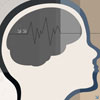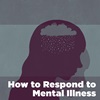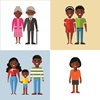Note: This article is excerpted from Troubled Minds: Mental Illness and the Church's Mission.
For the first couple of decades of Mom's full-blown illness and my family's crisis, one of the greatest catalysts to our pain was the sense that we were alone. Because we suffered mostly silently, we didn't find other people who were suffering in the same way. And because those other suffering people were silent too, we all thought we were the only ones. Now I know better. We weren't even close to alone.
More Common than You Think
Most people are surprised to learn that mental illness is incredibly common. In fact, mental disorders are the number-one cause of disability in North America. According to the National Institute of Mental Health and other experts, about one in four adults—a little more than 25 percent of Americans ages 18 and older—suffers from a diagnosable mental disorder in a given year. Yes, one in four. That equates to around 50 million people in the United States. And that's only in a given year. Because many mental illnesses (like depressive episodes) are short-term and not chronic, a higher percentage of people are affected by a mental illness at some point in their lives.
Serious and chronic mental illness is less common but still present among 6 percent of the population, or 1 in 17 adults. That's almost 12 million people in the United States. Those mental illnesses considered "serious" are major depression, schizophrenia, bipolar disorder, obsessive-compulsive disorder (OCD), panic disorder, posttraumatic stress disorder (PTSD) and borderline personality disorder.
Other mental illnesses, while not as serious as those called clinically "serious" by psychiatrists, still must be taken seriously. The National Alliance on Mental Illness (NAMI) defines mental illnesses as "medical conditions that disrupt a person's thinking, feeling, mood, ability to relate to others, and daily functioning" and "often result in a diminished capacity for coping with the ordinary demands of life." All mental illness, by definition, impairs a person's basic functioning and disrupts the kind of social connections God created us to enjoy (see Genesis 2:18-23; Colossians 3:12-15; 1 John 4:7-12).
Antipsychotics are now the top-selling class of drugs in the United States. This is because of their growing use not only to treat serious psychotic disorders but also to address a broader array of problems. These drugs have powerful side effects, which contribute to the reluctance of people who need them to take them consistently. These side effects themselves can impair a person's functioning as powerfully as an illness can.
What about those under the age of 18? Many people think of mental illness as an adult problem because such illnesses in children are not as well documented and well known as they are in adults. People hesitate to diagnose—and thereby label—children, who are still forming and who may "grow out of" a mental illness. Perhaps another reason is that, because our bodies begin to break down as we age, we tend to associate illness in general with adulthood. And we find it especially tragic when people in the "prime of life" go through serious suffering.
But the nature of much mental illness makes it different from most other disabling disease. The National Institute of Mental Health calls mental disorders "the chronic diseases of the young." Many of these disorders begin early in life. According to one of the institute's press releases:
Half of all lifetime cases begin by age 14; three quarters have begun by age 24… . For example, anxiety disorders often begin in late childhood, mood disorders in late adolescence, and substance abuse in the early 20s. Unlike heart disease or most cancers, young people with mental disorders suffer disability when they are in the prime of life, when they would normally be the most productive.
According to the U.S. Surgeon General, every year an estimated 20 percent of children in the United States are at least mildly impaired by some type of diagnosable mental illness. And about 5 to 9 percent of children ages 9 to 17 have a "serious emotional disturbance." That's between three and seven million children in serious trouble—and millions of families in crisis.
Nearly everyone is touched by mental illness—directly or indirectly—at some point. From the millions of people with diagnosable mental illness, the suffering extends to parents, children, grandparents, siblings, aunts, uncles, friends, coworkers, neighbors, and church members. If your church is typical of the U.S. population, on any given Sunday one in four adults and one in five children sitting around you are suffering from a mental illness. Many of them are under the influence of powerful antipsychotic drugs and their side effects.
The Church's Response to Disease
Against the backdrop of knowledge about various types of mental illness and their frequency, consider the statistics for a few other types of serious illness.
Heart disease. Heart disease is a serious problem. In the United States, it is responsible for 26 percent of deaths, with approximately 0.2 percent of the population dying from heart disease every year. According to the Centers for Disease Control and Prevention, 11.5 percent of adults in the United States have some kind of heart disease.
Cancer. Cancer strikes more than 1.5 million people, with new diagnoses every year in the United States. That means about 0.5 percent of the population is diagnosed with cancer annually. This includes the entire population—all ages and races—and all forms of cancer.
HIV and AIDS. The Centers for Disease Control and Prevention estimates that approximately 50 thousand people are infected with HIV each year in the United States. That's about 0.01 percent of the population. An estimated 35 thousand (0.01 percent) per year develop AIDS and just over 1 million (3.7 percent) are living with AIDS.
Diabetes. According to the American Diabetes Association, 25.8 million people—adults and children—in the United States are afflicted with diabetes. This is about 8 percent of the population. Among adults age 20 and older, 11 percent have diabetes, and about 2 million cases are diagnosed each year.
These diseases are serious, life threatening, and grief inducing. They provide clear evidence of humanity's great fall, with its consequences of decay and inevitable death. Everything we touch turns to dust, including these cursed bodies of ours. Because of genetic predispositions and lifestyle choices, we all participate in the suffering that is our lot as people living in the shadow of rebellion against the God of the universe. And sometimes, because we are drawn to our foolishness like a dog to its own vomit (Proverbs 26:11), we actually hasten death through our choices.
So what does the church do in the face of these consequences of sin? We rightly minister to the victims of these diseases. Over recent decades, the church has grown more open in its acceptance of suffering people and in its willingness to suffer alongside them. We visit them in the hospital, raise money to fight their diseases and pay their bills. We bring them meals, drive them to appointments and babysit their kids. We pray for them in our services, ask them how they're feeling and accommodate them with special foods at our potlucks.
And as we're busy enthusiastically delivering meals to suffering people, we are largely ignoring the afflictions of 25 percent of our population. That's about equal to the total percentage of people diagnosed with cancer each year, those living with heart disease, those infected with HIV and AIDS, and those afflicted with diabetes—combined. No wonder several people I talked with called mental illness the "no-casserole illness." In contrast to the care we provide for others, we have very little patience with those whose diseases happen to attack their minds. And many people suffer in silence.
To learn how you and your group can help those with mental illness, use our study.
—Taken from Troubled Minds by Amy Simpson. Copyright 2013 by Amy Simpson. Used by permission of InterVarsity Press.










